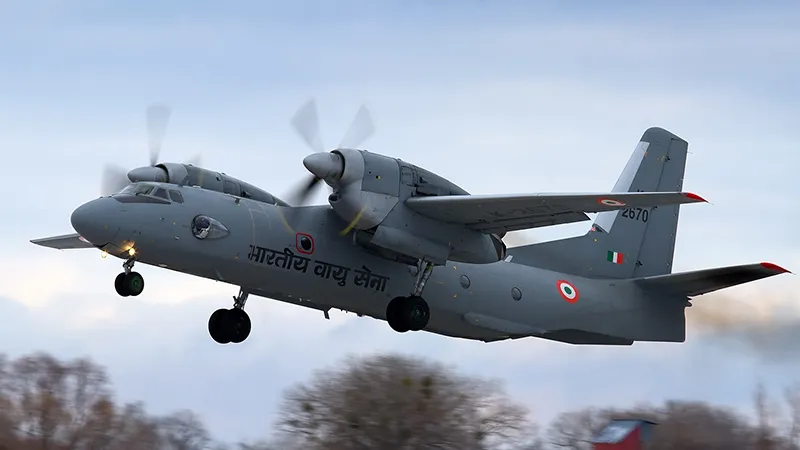The disappearance of Indian Air Force’s (IAF) AN-32 plane while flying from Chennai to Port Blair, with 29 people onboard last Friday, brings back the focus on the IAF’s fleet of ageing transport aircraft and also the disjointed defence planning and modernisation of the Indian Armed Forces. Several reports by the Comptroller and Auditor-General (CAG) encapsulate how mismanagement has resulted in chronic shortage of equipment and ammunition, and low levels of serviceability for equipment already in service.
Last Friday’s loss of the AN-32 adds to the long list of more than 40 military aircraft and helicopters that have crashed since 2011. AN-32 aircraft were inducted in the 1980s, and are an integral part of daily operations of the IAF — transporting troops, material and dropping rations and stores at high altitude posts. They have also been deployed for search and rescue operations during natural disasters.
However, the AN-32s have been going through a controversial refit and upgradation programme, which is meant to increase their technical life to 40 years at an approximate cost of $400 million. In March last year, five AN-32 planes sent to Ukraine for refit and refurbishment, reportedly disappeared before being found.
Also, after receiving the first 40 re-fitted aircraft, another 64 AN-32s were to be upgraded at the Base Repair Depot in Kanpur with Ukrainian support. However, only 10 more received this upgrade, as the Ukrainian engineers left and components were not delivered. The missing AN-32 was one of the 10 upgraded in September in Kanpur and it suffered three technical snags in July.
The IAF’s transport fleet, with the recent addition of modern assets in the form of Boeing C-17 Globemaster and Lockheed Martin C-130, has seen an improvement in its air mobility capabilities. However, mismanagement in procurement and usage are rife with these recent acquisitions.
The contract for the 10 C-17s, for example, had an optional follow-on clause for the purchase of six additional aircraft. The IAF decided it needed only three more, but by the time this decision was made, Boeing had shut down its production line and had only one aircraft to sell.
Last week, the CAG said that the operational capabilities of C-17s were underutilised, partially due to the non-availability of runways with appropriate pavement classification numbers and a lack of ground equipment at various bases.
The IAF also operates a fleet of Avro aircraft from the 1950s. It is becoming increasingly difficult to maintain vintage aircraft as serviceability is low and technical snags are frequent. Such aircraft are effectively obsolete.
On the other hand, the historic decision by the Defence Acquisition Council to approve Tata Advanced Systems Ltd from the private sector to tie up with Airbus and manufacture the C-295 transport aircraft, so to replace the aging Avro aircraft in a two billion dollar deal, remains stuck at the initial paper evaluation stage. It is still awaiting clearance.
Fast-tracking and acquiring the C-295 aircraft, not only to replace the Avro, but also the ageing AN-32, will reduce cost-inefficiency. Also, we can avoid operating different aircraft for the same task.
Another jet, among the endless list of aircraft mooted to replace the IAF’s ageing transport fleet is the Multi-Role Transport Aircraft — a twin-jet with a payload capacity of approximately 18.5 tonnes. This is to be developed jointly by Russia’s United Aircraft Corporation and the Hindustan Aeronautics Ltd, both of which have invested $300 million. India was to acquire 45 aircraft, but the project has been stalled due to disagreement over the type of powerplant to be fitted on the aircraft.
The IAF will be better off with its transport platforms spread over just two to three types of aircraft, instead of the seven or so that its currently operates, to leverage engine and systems commonality and reduce costs in the form of maintenance, spare acquisition, pilot training etc.
Improving affordability in areas of acquisition, maintenance and training must receive primacy. The IAF needs to adopt an approach of acquisition where it receives the greatest returns on its investments, closes its capability gaps while taking cognisance of spending capability. The loss of the AN-32 and its 29 occupants is a chilling reminder of the costs of delay in decision-making in defence procurement and modernisation.
This commentary originally appeared in The Pioneer.
The views expressed above belong to the author(s). ORF research and analyses now available on Telegram! Click here to access our curated content — blogs, longforms and interviews.




 PREV
PREV


